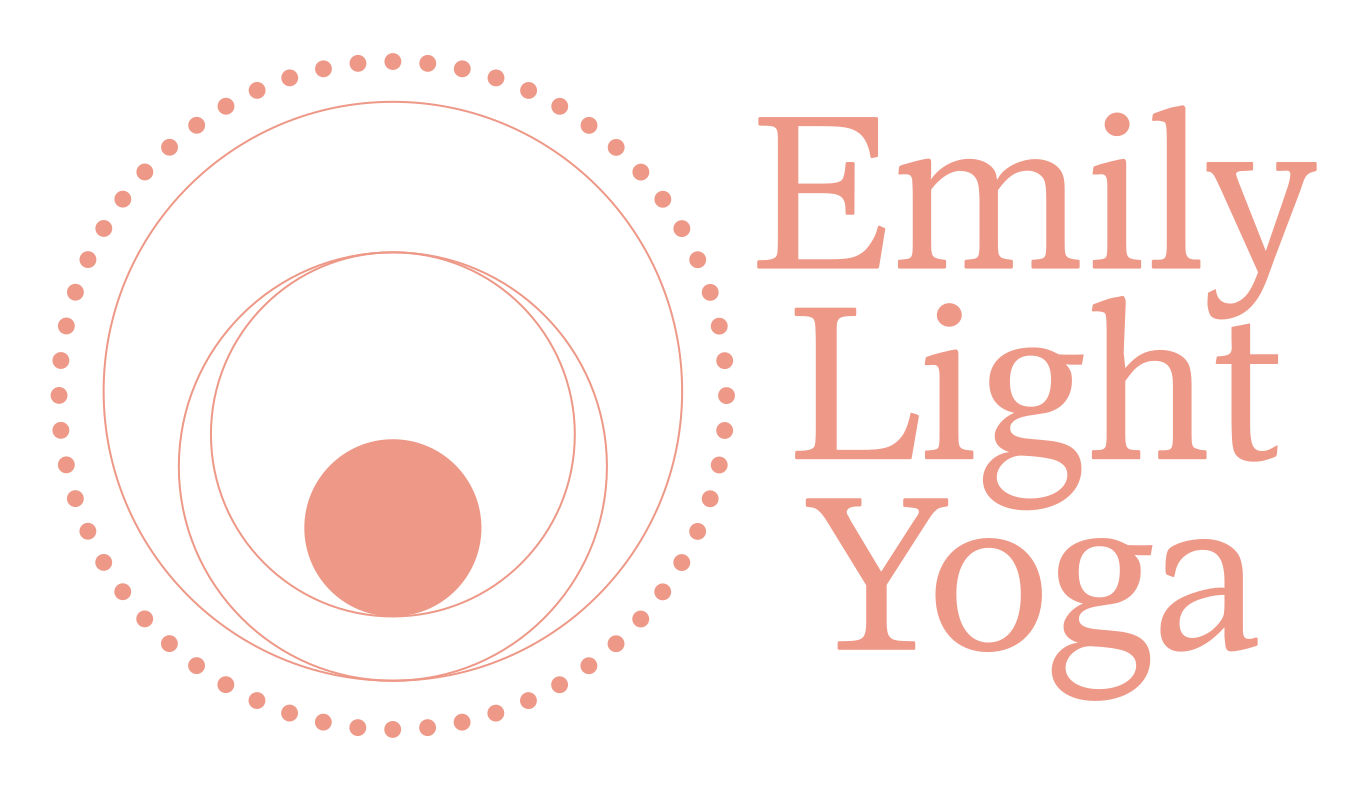Aligning with Your Highest Self - Isvara Pranidhana
*Image caption: In Supported Reclined Bound Angle Pose, I’m resting with a bolster under my back, blocks underneath my legs, and cushioned by a folded blanket on a wooden floor. The bolster, blocks, and my pants are purple, and my tank top is green. I have my right hand on my belly and my left hand on my heart.
Evolution is not linear.
There are ups and downs and sideways turns.
A growing edge that’s awake and alive in my life right now is the practice of trust. Trust in my own knowing. Trust in my body. Trust in my nervous system. Trust in my intuition.
Recently I found myself in a situation where I lost connection to my intuition. Perhaps it’s more accurate to say that I didn’t understand her right away. The wisdom my body speaks was tamped down by my thinking mind.
“He’s the expert, I’m sure he knows what he’s doing.”
Looking back, I clearly remember moments of feeling the pit of my stomach knot up, my heart sink, and my throat all but close. When I did start to hear my body speak, initially I didn’t interpret the message quite right. Muddied by insecurity and hope, I disregarded and intellectualized her warnings of danger.
“Of course, I’m feeling some anxiety, this is such a big project.”
Trust
I trusted someone else over my own body and intuition, and I did so by rationalizing and labeling bodily sensations, rather than revering this wisdom. I’ve experienced lots of anxiety in my life, and those bodily sensations often accompany my emotional experience of anxiety.
So, my thinking mind spun the story of:
“This is just anxiety again, which is my thing to work through. My problem. My weakness. It’s not about him, it’s about me.”
But it was about him. And me. My body wasn’t sensing safety, rather, my nervous system was neurocepting danger, and in sympathetic flight mode. But rather than fleeing from the source of danger (which I wasn’t able to), I was subconsciously fleeing from my intuition. I was running away from myself and in this particular circumstance, I ran long enough that I lost myself for a moment… rather, I lost myself for an entire day.
TW: Trauma language
Getting Stuck
The incoherence of my body’s reaction to danger, and my mind’s oppositional trauma response of shutting that recognition of danger down, propelled me into a state of freeze. For 24 hours my nervous system got stuck. The sympathetic charge (which was communicated through those bodily sensations in my belly, heart and throat) grew too big for my system to tolerate, in part because my body wasn’t able to mobilize during that sympathetic arousal. I didn’t have access to the capacity and agency needed to flee or fight the source of danger, so when I surpassed my threshold for holding sympathetic energy, my nervous system did its skillful job of simultaneously putting on the brakes and slowing bodily functions down to conserve resources.
My experience of freeze wasn’t the deer-frozen-in-headlights kind of freeze. That’s a gross example of this mixed sympathetic and parasympathetic state. Freeze can also look and feel like spacey-ness, numbness, disconnection from sensation, emotion and others. Freeze may present as confusion, overwhelm, lethargy and disassociation. Any of these expressions combined with the energy of anxiety or panic is the nervous system state of freeze. Immobilization (parasympathetic) and mobilization (sympathetic) are happening at the same time.
I could wax on here about the nuances of the Polyvagal Model, strategies to learn the unique language of your body, how to mobilize during that sympathetic phase before freeze happens, and what to do when the nervous system gets stuck. However, my intention in sharing this recent experience with you is to give you a real-life example of living one’s yoga.
I’ve been practicing for two decades - exactly half of my life. I’ve been teaching for 15 years. And I’m still learning to trust myself.
Isvara Pranidhana
Isvara Pranidhana is one of the personal guidelines or niyamas, in the ethics of yoga. It is the practice of living in alignment with our true nature, our highest Self.
Isvara Pranidhana Pronunciation and Translation
Isvara (ish-VAR-ah) Pranidhana (Pran-EE-dahn-a)
Isvara = cosmic consciousness, pure awareness, divine spirit or God
Pranidhanat = dedication, surrender or alignment
Isvara Pranidhana
Aligning with one’s highest Self
When we live in alignment with our values and we’re guided by our intuition, life is a little easier to navigate. By resourcing our wise selves, there’s less inner conflict and confusion when we’re making decisions of whom to work with, when to bring up that conversation, or which next step to take.
Where we get tripped up is in the practice of trusting what we feel and hear. Which is what happened to me in the situation I just described.
I felt bodily sensations of danger, but I wrote them off as an inappropriate response. Because of my history with trauma and anxiety, I still experience moments where my nervous system misinterprets certain situations as dangerous, when in reality I’m safe and not in danger. On the flip-side, my nervous system may not always catch subtle or red flag cues from others regarding their trustworthiness. This discernment has grown and refined over the years, but I still experience confusion sometimes.
Getting Un-Stuck
Almost exactly 24 hours after getting stuck, I was in the kitchen preparing dinner. All day I had been managing the peripheral noise of anxiety, while also feeling numb and disconnected. As I stirred a pan full of vegetables, the rumination that had been spinning in the background of my mind, came to the forefront, and the volume of those thoughts spiked. My heart started racing. I got hot and sweaty, and my tremor increased.
I kept telling myself to re-focus on the task at hand: “Feel the wooden spoon… smell the delicious food…”
It was impossible. I couldn’t focus on anything but those hamster-wheel thoughts. Typically, I didn’t have a difficult time concentrating. Why couldn’t I break free from this rumination??? And then it hit me:
“Oh! I SHOULD be paying attention to these sensations and thoughts – this is my nervous system getting unstuck and my intuition SCREAMING at me!”
The increase in mental activity and the hot/sweaty/shaky symptoms were all expressions of my nervous system moving from freeze back through the sympathetic arousal of fight.
I turned the stove off. I thanked my body for its guidance and persistence by pausing, quieting my eyes, and putting my hands on my heart. And then I took the action that was necessary to reclaim my own agency and power, by making a phone call and pulling the plug on that big project. That action was the mobilization that my body needed to regulate and return to a place of nervous system balance. I used the healthy fight energy that’s available in the sympathetic state of arousal to stand up for myself and to honor my inner guidance.
Tapas, Svadhyaya and Isvara Pranidhana
In the first essay I sent to you this year, I spoke of nourishing self-discipline, tapas.
The second essay I sent to you discussed self-study, svadhyaya.
And now you have this final piece - aligning with your highest Self, Isvara pranidhana.
Together, these three niyamas are considered to be the most important aspects of the practice in support of growth and evolution, both personally and collectively. Together they are referred to as the “Yoga of Action”.
The Yoga of Action
Here’s how the three pillars of the “Yoga of Action” play out in my experience:
To create the conditions necessary for my nervous system to develop greater accuracy in its ability to perceive safety and danger, I practice paying close attention to my internal and external experience (svadhyaya). I need to practice this self-inquiry (svadhyaya) regularly (tapas), so I can learn the language of my body and be guided by intuition (Isvara pranidhana).
When you’re nudging up against a growing edge, or when your nervous system gets stuck, I wish for you to remember what I’ve shared here:
Your body holds knowing and wisdom
You have access to your intuition
You are anti-fragile
The being that is you is in constant growth and renewal
Nothing is static, not even the experience of being stuck
You can learn to trust yourself
Big love,
Emily

